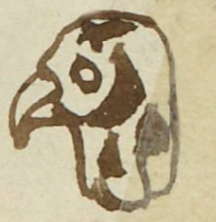zolin (MH508r)
This black-and-white painting of an element from the compound glyph Tecuhzol represents a quail (zolin). The glyphic element appears in the form of a bird's head in profile, looking toward the viewer's left. Its feathers are patches of black and white.
Stephanie Wood
The quail had a role in the religious life of the Nahuas, largely serving as offerings. Their remains are very prevalent in the finds at the Templo Mayor, and they are prominent in the Mixtecs' Codex Nuttall. For further information see Elena Mazzetto, "Quail in the Religious Life of the Ancient Nahuas", en Milbrath, Susan y Elizabeth Baquedano (coords.), 2023, Birds and Beasts of Ancient Mesoamerica. Animal Symbolism in the Postclassic Period, Denver, University Press of Colorado, pp. 200-219.
Stephanie Wood
1560
Jeff Haskett-Wood
quail, birds, feathers, ave, aves, pájaro, pájaros, pluma, plumas, animals, animales

zol(in), quail, https://nahuatl.wired-humanities.org/content/zolin
Matrícula de Huexotzinco, folio 508r, World Digital Library, https://www.loc.gov/resource/gdcwdl.wdl_15282/?sp=95&st=image
This manuscript is hosted by the Library of Congress and the World Digital Library; used here with the Creative Commons, “Attribution-NonCommercial-ShareAlike 3.0 License” (CC-BY-NC-SAq 3.0).




